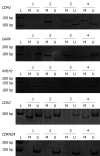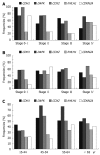Helicobacter pylori and EBV in gastric carcinomas: methylation status and microsatellite instability
- PMID: 20082476
- PMCID: PMC2807951
- DOI: 10.3748/wjg.v16.i3.312
Helicobacter pylori and EBV in gastric carcinomas: methylation status and microsatellite instability
Abstract
Aim: To verify the methylation status of CDH1, DAPK, COX2, hMLH1 and CDKN2A genes and to evaluate their association with Helicobacter pylori (H. pylori)-cagA(+) and Epstein Barr virus (EBV) infections in gastric adenocarcinomas.
Methods: Methylation-specific PCR (MSP) assay was performed in 89 primary gastric carcinomas (intestinal and diffuse types). Microsatellite instability (MSI) analysis was performed using the BAT26 primer set and PCR products were analyzed with the ABI PRISM 3100 Genetic Analyzer using Genescan 3.7 software (Applied Biosystems). Detection of H. pylori and genotyping were performed by PCR, using specific primers for ureaseC and cagA genes. The presence of EBV was assessed by in situ hybridization. Statistical analyses were performed using the chi(2) or Fisher's exact test.
Results: The most frequent hypermethylated gene was COX-2 (63.5%) followed by DAPK (55.7%), CDH1 (51%), CDKN2A (36%) and hMLH1 (30.3%). Intestinal and diffuse adenocarcinomas showed different methylation profiles and there was an association between methylation of E-CDH1 and H. pylori-cagA(+) in the intestinal adenocarcinoma type. MSI was correlated with hMLH1 methylation. There was an inverse correlation between DAPK hypermethylation and MSI.
Conclusion: We found a strong association between CDH1 methylation and H. pylori-cagA(+) in intestinal-type gastric cancer, association of MSI and better prognosis and an heterogeneous COX-2 overexpression.
Figures


Similar articles
-
MTHFR C677T polymorphism and differential methylation status in gastric cancer: an association with Helicobacter pylori infection.Virchows Arch. 2010 Dec;457(6):627-33. doi: 10.1007/s00428-010-0996-3. Epub 2010 Oct 19. Virchows Arch. 2010. PMID: 20957490
-
MGMT and MLH1 methylation in Helicobacter pylori-infected children and adults.World J Gastroenterol. 2013 May 28;19(20):3043-51. doi: 10.3748/wjg.v19.i20.3043. World J Gastroenterol. 2013. PMID: 23716983 Free PMC article.
-
Inactivation of COX-2, HMLH1 and CDKN2A gene by promoter methylation in gastric cancer: relationship with histological subtype, tumor location and Helicobacter pylori genotype.Pathobiology. 2011;78(5):266-76. doi: 10.1159/000329475. Epub 2011 Aug 17. Pathobiology. 2011. PMID: 21849808
-
Gene methylation in gastric cancer.Clin Chim Acta. 2013 Sep 23;424:53-65. doi: 10.1016/j.cca.2013.05.002. Epub 2013 May 10. Clin Chim Acta. 2013. PMID: 23669186 Review.
-
Epstein-Barr virus-associated lymphoepithelioma-like gastric carcinoma.Arch Pathol Lab Med. 2008 Apr;132(4):706-9. doi: 10.5858/2008-132-706-EVLGC. Arch Pathol Lab Med. 2008. PMID: 18384225 Review.
Cited by
-
Identification of Differentially Expressed Genes Reveals BGN Predicting Overall Survival and Tumor Immune Infiltration of Gastric Cancer.Comput Math Methods Med. 2021 Nov 26;2021:5494840. doi: 10.1155/2021/5494840. eCollection 2021. Comput Math Methods Med. 2021. PMID: 34868341 Free PMC article.
-
DNA methylation and microRNA biomarkers for noninvasive detection of gastric and colorectal cancer.Biochem Biophys Res Commun. 2014 Dec 5;455(1-2):43-57. doi: 10.1016/j.bbrc.2014.08.001. Epub 2014 Aug 13. Biochem Biophys Res Commun. 2014. PMID: 25128828 Free PMC article. Review.
-
Status of Epstein-Barr Virus Coinfection with Helicobacter pylori in Gastric Cancer.J Oncol. 2017;2017:3456264. doi: 10.1155/2017/3456264. Epub 2017 Mar 21. J Oncol. 2017. PMID: 28421114 Free PMC article. Review.
-
Helicobacter pylori and Epstein-Barr Virus Co-Infection in Gastric Disease: What Is the Correlation with p53 Mutation, Genes Methylation and Microsatellite Instability in a Cohort of Sicilian Population?Int J Mol Sci. 2023 Apr 30;24(9):8104. doi: 10.3390/ijms24098104. Int J Mol Sci. 2023. PMID: 37175810 Free PMC article.
-
Promoter hypermethylation of p14 (ARF) , RB, and INK4 gene family in hepatocellular carcinoma with hepatitis B virus infection.Tumour Biol. 2014 Mar;35(3):2795-802. doi: 10.1007/s13277-013-1372-0. Epub 2013 Nov 20. Tumour Biol. 2014. PMID: 24254306
References
-
- Parkin DM, Bray F, Ferlay J, Pisani P. Global cancer statistics, 2002. CA Cancer J Clin. 2005;55:74–108. - PubMed
-
- Kamangar F, Dores GM, Anderson WF. Patterns of cancer incidence, mortality, and prevalence across five continents: defining priorities to reduce cancer disparities in different geographic regions of the world. J Clin Oncol. 2006;24:2137–2150. - PubMed
-
- Hartgrink HH, Putter H, Klein Kranenbarg E, Bonenkamp JJ, van de Velde CJ. Value of palliative resection in gastric cancer. Br J Surg. 2002;89:1438–1443. - PubMed
-
- Lauren P. THE two histological main types of gastric carcinoma: diffuse and so-called intestinal-type carcinoma. An attempt at a histo-clinical classification. Acta Pathol Microbiol Scand. 1965;64:31–49. - PubMed
-
- Kass SU, Pruss D, Wolffe AP. How does DNA methylation repress transcription. Trends Genet. 1997;13:444–449. - PubMed
Publication types
MeSH terms
Substances
LinkOut - more resources
Full Text Sources
Medical
Research Materials
Miscellaneous

